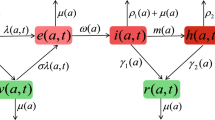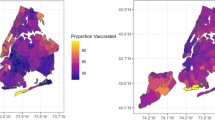Abstract
In this paper, we improve the classic SEIR model by separating the juvenile group and the adult group to better describe the dynamics of childhood infectious diseases. We perform stability analysis to study the asymptotic dynamics of the new model, and perform sensitivity analysis to uncover the relative importance of the parameters on infection. The transmission rate is a key parameter in controlling the spread of an infectious disease as it directly determines the disease incidence. However, it is essentially impossible to measure the transmission rate for certain infectious diseases. We introduce an inverse method for our new model, which can extract the time-dependent transmission rate from either prevalence data or incidence data in existing open databases. Pre- and post-vaccination measles data sets from Liverpool and London are applied to estimate the time-varying transmission rate. From the Fourier transform of the transmission rate of Liverpool and London, we observe two spectral peaks with frequencies 1/year and 3/year. These dominant frequencies are robust with respect to different initial values. The dominant 1/year frequency is consistent with common belief that measles is driven by seasonal factors such as environmental changes and immune system changes and the 3/year frequency indicates the superiority of school contacts in driving measles transmission over other seasonal factors. Our results show that in coastal cities, the main modulator of the transmission of measles virus, paramyxovirus, is school seasons. On the other hand, in landlocked cities, both weather and school seasons have almost the same influence on paramyxovirus transmission.









Similar content being viewed by others
References
Anderson RM, May RM (1991) Infectious diseases of humans. Oxford University Press, Oxford
Bauch CT, Earn DJD (2003) Transients and attractors in epidemics. Proc R Soc Lond B 270:1573–1578
Becker NG (1989) Analysis of infectious disease data. Chapman and Hall, New York
Earn DJD, Rohani P, Bolker BM, Grenfell BT (2000) A simple model for complex dynamical transitions in epidemics. Science 287:667–670
Fine PE, Clarkson JA (1985) The efficiency of Measles and Pertussis Notification in England and Wales. Int J Epidemiol 14(1):153–168
Grassly NC, Fraser C (2006) Seasonal infectious disease epidemiology. Proc R Soc B Biol Sci 273:2541–2550
Glendinning P, Perry LP (1997) Melnikov analysis of chaos in a simple epidemiological model. J Math Biol 35(3):359
Hadeler KP (2011) Parameter identification in epidemic models. Math Biosci 229(2):185–189
Keeling MJ, Rohani P (2008) Modeling infectious diseases in humans and animals. Princeton University Press, Princeton
Keeling MJ, Rohani P, Grenfell BT (2001) Seasonally forced disease dynamics explored as switching between attractors. Phys D 148:317–335
Lombard M, Pastoret PP, Moulin AM (2007) A brief history of vaccines and vaccination. Rev Sci Tech Off Int Epizoot 26(1):29
Pollicott M, Wang H, Weiss H (2010) Recovering the time-dependent transmission rate from infection data. arXiv:0907.3529v3
Pollicott M, Wang H, Weiss H (2012) Extracting the time-dependent transmission rate from infection data via solution of an inverse ODE problem. J Biol Dyn 6(2):509–523
Rohani P, Keeling MJ, Grenfell BT (2002) The interplay between determinism and stochasticity in childhood diseases. Am Nat 159:469–481
The weekly OPCS (Office of Population Censuses and Surveys) reports. The Registrar General’s Quarterly or Annual Reports and various English census reports 1948–1967
Author information
Authors and Affiliations
Corresponding author
Appendix
Appendix
Proof of Theorem 1
Positivity describes the property that for any positive initial values, the solution of a system will stay positive. The solution of an ODE \( \frac{d y_i}{\mathrm{d}t}=f_i(y_1,y_2,\ldots ,y_n)~~(n \in \mathbb {N}) \) is said to be positive for any positive initial values if \( \forall ~ 1\le i \le n, ~f_i\ge 0 \) when \( ~ y_i=0 \) and \( y_j\ge 0, ~~j\ne i. \) Denoting S, E, I, R, A as \( f_i\) and the functions on the right-hand side of (1) as \( y_i ,~ for ~~1\le i \le 5 \), respectively, we have that \( f_1=\delta y_5\ge 0, f_2=\beta y_1y_3\ge 0 ,f_3=ay_2\ge 0, f_4=\nu y_3\ge 0, f_5=g(y_1+y_2+y_3+y_4)\ge 0\). Hence, the solution of (1) is positive for any positive initial values. Also, we notice that S, E, I, R, and A sum to 1 and their derivatives sum to 0. Hence, we can conclude that the solution of (1) will stay in {( S, E, I, R, A ): \(S\ge 0,E\ge 0,I\ge 0,R\ge 0,A\ge 0, S+E+I+R+A=1\)} for any positive initial values. \(\square \)
Proof of Theorem 2
Suppose \( (S^*,E^*,I^*,R^*,A^*) \) is an equilibrium point, then it should satisfy
From (17), we know that \( A^*=\frac{g}{g+\delta } \). From (15), we have \( E^*=\frac{\nu +g}{a} I^*\). Plugging it into (14) we get
If \(I^*=0\), then \( E^*=\frac{\nu +g}{a}I^*=0 , R^*=\frac{\nu }{g}I^*=0 , S^*=\frac{\delta }{g}A^*=\frac{\delta }{g+\delta } \).
If \(S^*=\frac{(a+g)(\nu +g)}{a\beta }\), then
Hence, there are two equilibria: the disease-free equilibrium point \(~(S_1^*,~E_1^*,~I_1^*,~R_1^*, A_1^*)=\left( \frac{\delta }{g+\delta },~0,~0,~0,~\frac{g}{g+\delta }\right) \) and the endemic equilibrium point
To determine the stability of the Equilibria, we first calculate the Jacobian matrix of the SEIRA model. Since S, E, I, R, A sum up to 1, there are only four free variables. To calculate the Jacobian matrix, we only need to consider any four of them. We ignore the fourth equation of system (1) and obtain the Jacobian matrix as
-
Notice that \( I_2^* \) can be rewritten as \(I_2^*=\frac{g}{\beta (a+g)(g+\delta )(\nu +g)}(a\delta \beta -(a+g)(g+\delta )(\nu +g)),\) thus for \( a\delta \beta <(a+g)(g+\delta )(\nu +g), I_2^*<0 , R_2^*=\frac{\nu }{g}I_2^*<0 \), and \( E_2^*=\frac{\nu +g}{a}I_2^*<0 .\) Thus, the endemic equilibrium is not feasible for \( a\delta \beta <(a+g)(g+\delta )(\nu +g).\) For the disease-free equilibrium, the Jacobian matrix is
$$\begin{aligned} J\left( S_1^*, E_1^*, I_1^*, A_1^*\right) =\left( \begin{matrix} -g&{}0&{}-\frac{\delta }{g+\delta }\beta &{}\delta \\ 0&{}-(a+g)&{}\frac{\delta }{g+\delta }\beta &{}0\\ 0&{}a&{}-(\nu +g)&{}0\\ 0 &{} 0 &{} 0&{}-(g+\delta ) \end{matrix} \right) \end{aligned}$$and the characteristic equation is \( (\lambda +g)(\lambda +\nu +g)(\lambda ^2+(a+2g+\nu )\lambda +(a+g)(\nu +g)-\frac{a\delta }{g+\delta }\beta )=0. \) Solving this, we obtain the following eigenvalues \( \lambda _1=-g<0 , \lambda _2=-(g+\delta ) <0\) and
$$\begin{aligned} \lambda _{3,4}= & {} \frac{-(a+2g+\nu )\pm \sqrt{(a+2g+\nu )^2-4((a+g)(\nu +g)-\frac{a\delta }{g+\delta }\beta )}}{2}\\= & {} \frac{-(a+2g+\nu )\pm \sqrt{(a-\nu )^2+4\frac{a\delta }{g+\delta }\beta }}{2} \end{aligned}$$If \( (a+g)(\nu +g)-\frac{a\delta }{g+\delta }\beta >0 , \lambda _{3} \) and \( \lambda _{4} \) will both be less than zero. Hence, the disease-free equilibrium point is asymptotically stable \( \Longleftrightarrow (a+g)(\nu +g)-\frac{a\delta }{g+\delta }\beta >0 \Longleftrightarrow a\delta \beta <(a+g)(g+\delta )(\nu +g). \)
-
When \( a\delta \beta >(a+g)(g+\delta )(\nu +g), \) we have that \( S_2^*=\frac{ (a+g)(\nu +g) }{a\beta }>0 , A_2^*=\frac{g}{g+\delta }>0. \) Also, \(I_2^*=\frac{g}{\beta (a+g)(g+\delta )(\nu +g)}(a\delta \beta -(a+g)(g+\delta )(\nu +g))>0,\) and \( R_2^*=\frac{\nu }{g}I_2^*>0 , E_2^*=\frac{\nu +g}{a}I_2^*>0.\) Thus, the endemic equilibrium is feasible when all the parameters are positive and \( a\delta \beta >(a+g)(g+\delta )(\nu +g). \) Also, when \( a\delta \beta >(a+g)(g+\delta )(\nu +g), \) from the previous proof, we know that the disease-free equilibrium is unstable. For the endemic equilibrium, once again, we calculate the Jacobian matrix:
$$\begin{aligned} J\left( S_2^*, E_2^*, I_2^*, A_2^*\right) =\left( \begin{matrix} -\beta I_2^*-g&{}0&{}-\beta S_2^*&{}\delta \\ \beta I_2^*&{}-(a+g)&{}\beta S_2^*&{}0\\ 0&{}a&{}-(\nu +g)&{}0\\ 0 &{} 0 &{} 0&{}-(g+\delta ) \end{matrix} \right) . \end{aligned}$$From the above matrix, we can see that one eigenvalue of the characteristic equation is \(\lambda _1=-(g+\delta )\), and the other three satisfy \( \lambda ^3+(-\mathrm{tr}(M))\lambda ^2+(\alpha (M))\lambda +(-\mathrm{Det}(M))=0,\) where \(\mathrm{tr}(M)=-(\beta I_2^*+a+3g+\nu ),\) \(\alpha (M)= \left( \beta I_2^*+g\right) (a+g)+\left( \beta I_2^*+g\right) (\nu +g)+(a+g)(\nu +g)-a\beta S_2^*,\) \(\mathrm{Det}(M) =-\left( \beta I_2^*+g\right) (a+g)(\nu +g)+ag\beta S_2^*.\) To study stability, we apply the third-order Routh–Hurwitz stability criterion. We first review the third-order Routh–Hurwitz stability criterion. Third-Order Routh–Hurwitz stability Criterion Real parts of all solutions of a third-order polynomial \( P(s) = a_3s^3 + a_2s^2 + a_1s + a_0 = 0 \) are negative if the coefficients satisfy \( a_3 > 0 ,a_3 > 0,a_1 > 0,a_0 > 0\) and \( a_2a_1 > a_3a_0 \). Thus, for our characteristic equation we have that
$$\begin{aligned} a_3= & {} 1>0 ,\\ a_2= & {} -\mathrm{tr}(M)=\beta I_2^*+3g+a+\nu >0 ,\\ a_1= & {} \alpha (M)= \left( \beta I_2^*+g\right) (a+g)+\left( \beta I_2^*+g\right) (\nu +g)\\&+(a+g)(\nu +g)-a\beta S_2^*\\= & {} \left( \beta I_2^*+g\right) (a+g)+\left( \beta I_2^*+g\right) (\nu +g)+(a+g)(\nu +g)\\&-a\beta \frac{(a+g)(\nu +g)}{a\beta }\\= & {} (\beta I_2^*+g)(a+2g+\nu )>0,\\ a_0= & {} -\mathrm{Det}(M)=\left( \beta I_2^*+g\right) (a+g)(\nu +g)-ag\beta S_2^*\\= & {} \beta I_2^*(a+g)(\nu +g)+g(a+g)(\nu +g)-ag\beta S_2^*\\= & {} \beta I_2^*(a+g)(\nu +g)+g(a+g)(\nu +g)-ag\beta \frac{(a+g)(\nu +g)}{a\beta }\\= & {} \beta I_2^*(a+g)(\nu +g)>0,\\ a_2a_1= & {} \alpha (M)*(-\mathrm{tr}(M))\\= & {} (\beta I_2^*+g)(a+2g+\nu )(\beta I_2^*+3g+a+\nu )\\> & {} \beta I_2^*(a+g)(\nu +g)=-\mathrm{Det}(M)=a_3a_0. \end{aligned}$$Hence, the conditions of Routh–Hurwitz stability criterion are satisfied. The endemic equilibrium is thus asymptotically stable if all the parameters are positive and \( a\delta \beta >(a+g)(g+\delta )(\nu +g). \) \(\square \)
Proof of Theorem 3
Rewriting the third equation of System (1) as \(f'(t)+(\nu +g)f(t)=aE(t)\) and differentiating both sides we get: \(f''(t)+(\nu +g)f'(t)=aE'(t)\). Plugging the second and third equations of (1) into the above equation, we have
Rewriting the above equation as
i.e., \(aS(t)=\frac{H(t)}{\beta (t) f(t)}.\)
Taking the first and second derivatives of the above equation, we get
where \( A=H''f^3-Hf''f^2-2H'f'f^2+2H(f')^2f, B=2Hf'f^2-2H'f^3, C=2Hf^3, D=-Hf^3.\)
Since \( S+E+I+R+A=1\), i.e., \(S+E+I+R=1-A\), the fifth equation of (1) becomes \(A'=g(S+E+I+R)-\delta A=g(1-A)-\delta A=g-(g+\delta )A.\)
Taking the derivative of the first equation of (1) with respect to t we have: \(S''+(\beta SI)'+gS'=\delta A'\), plugging in the first and fifth equation of (1) we get
Multiplying both sides of the above equation by a and simplifying gives
Substituting for aS, \(aS'\) and \(aS''\) we have
Multiplying both sides of the equation by \(\beta ^4f^4\) and expanding we get
This implies
i.e.,
where
Notice that \( N=-2M \), Eq. (18) becomes
Dividing by \( \beta ^4 \) we get
Let \( y=\beta ^{-1} , y'=-\beta ^{-2}\beta ', ~y''=2\beta ^{-3}(\beta ')^2-\beta ^{-2}\beta ''\). (18) can be rewritten as \( My''+Py'+Qy+L=0\) with \(y=\beta ^{-1}. \) \(\square \)
Proof of Theorem 4
Solving the equations in the system using the method of variation of parameters, we obtain
Plug (22) into (21) and plug (19) into (20):
Thus, \(\beta (t)=\frac{\omega (t)}{S(t)I(t)}\) with S(t) and I(t) given in (9) and (10). \(\square \)
Proof of Theorem 5
Using the same symbols as in the qualitative analysis section before, we have that \( f_1=\delta (1-p) y_5\ge 0,~ f_2=\beta y_1y_3\ge 0 ,~f_3=ay_2\ge 0,~ f_4=\nu y_3+\delta p y_5\ge 0,~ f_5=g(y_1+y_2+y_3+y_4)\ge 0\). Therefore the solution to system (11) is positive for any positive initial values. Also, boundedness property is the same as with the SEIRA model without vaccination analyze above. Combining positivity and boundedness, we conclude that the solution of (11) will stay in {( S, E, I, R, A ): \(S\ge 0,E\ge 0,I\ge 0,R\ge 0,A\ge 0, S+E+I+R+A=1\)} for any positive initial values.\(\square \)
Proof of Theorem 6
Same as the proof of Theorem 2. \(\square \)
Rights and permissions
About this article
Cite this article
Kong, J.D., Jin, C. & Wang, H. The Inverse Method for a Childhood Infectious Disease Model with Its Application to Pre-vaccination and Post-vaccination Measles Data. Bull Math Biol 77, 2231–2263 (2015). https://doi.org/10.1007/s11538-015-0121-5
Received:
Accepted:
Published:
Issue Date:
DOI: https://doi.org/10.1007/s11538-015-0121-5




